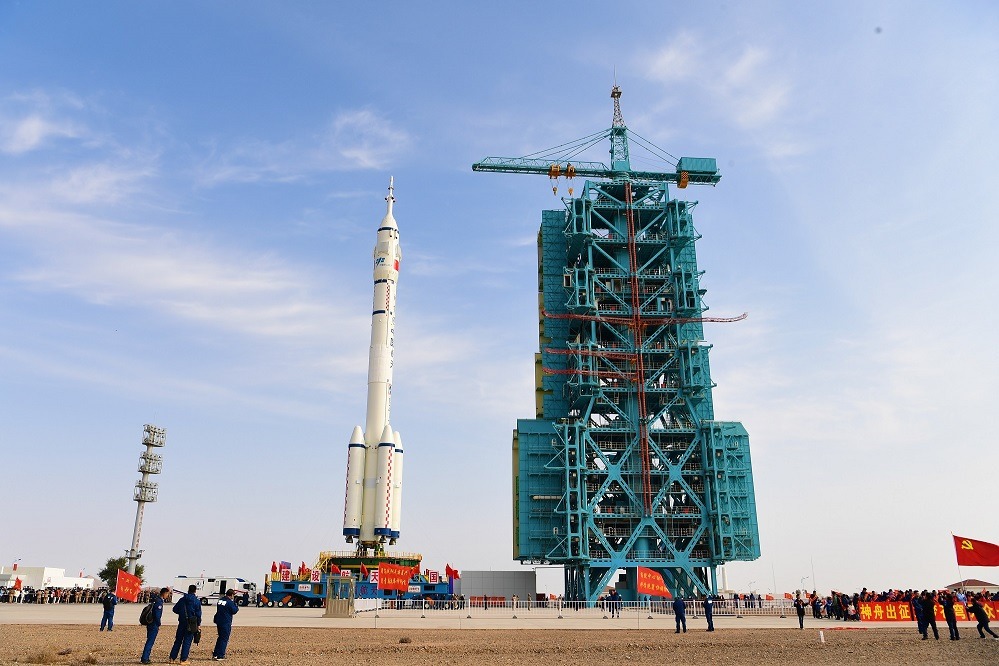Solving human-elephant conflict worldwide
Ecns.cn | Updated: 2023-01-17 16:42

In recent years, because of degrading habitats, more and more wild elephants walk out of the forest and enter the area of human activity. As human and elephant habitats increasingly overlap, conflict between the two species is becoming more and more fierce. This is not only a challenge faced by many countries where wild elephants live, but also a microcosm of the international conflict between biodiversity conservation and economic and social development. As World Elephant Day on Aug. 12 approached, Chen Fei, a director of the Asian Elephant Research Center of China's National Forestry and Grassland Administration, and Ahimsa Campos-Arceiz, a renowned international elephant expert and researcher in the Megafauna Ecology and Conservation Group at the Chinese Academy of Sciences's Xishuangbanna Tropical Botanical Garden, were invited for a dialogue in the “W. E. Talk” section of China News Service (CNS).
Here are the excerpts from the transcript:
CNS: Last year, more than 10 wild elephants in Yunnan Province safely finished their northbound trip, returning to their natural habitat. This attracted world attention to the problem of human-elephant conflict. What results in human-elephant conflict? What is its impact?
Chen: A number of human-elephant conflicts result from habitat loss and fragmentation. Human-elephant conflict is common in the global areas where elephants are distributed, no matter whether they are Asian or African elephants, which brought about heavy losses. In the last 100 years, the population of African elephants has decreased from 3 million to 5 million to 470,000 to 690,000; and the population of Asian elephants has decreased from 100,000 to 40,000 to 50,000. The elephant population has been dwindling because of habitat loss, ivory poaching and human-elephant conflict. Humans are also facing serious threats and losses. In India and Sri Lanka, over 100 people are killed or injured each year i elephant accidents. In Kenya, more than 200 people have died in African elephant accidents in the last seven years; at the same time, residents also suffer a lot of property losses. Some peasants may lose their livelihood for a year because of temporary plunder by elephants, and larger farms suffer great losses every year.
Campos-Arceiz: In fact, as long as humans and elephants live on the same land, no matter what the local climate, environment and culture, human-elephant conflict will inevitably occur. The essence of it is the competition for resources, which has existed since ancient times. However, as humans have appropriated more and more natural resources, human factors have prevailed. Human-elephant conflict becomes directly due to the loss of natural habitat.
CNS: What measures have the countries where elephants are found taken to tackle the human-elephant conflict? And what is the effect?
Chen: In recent years, the awareness of the need to protect Asian elephants has gradually increased. Asian elephants have become unafraid of human beings and frequently walk out of the reserve to eat crops. In addition, the number of Asian elephants has increased, making the conflict worse. In other countries, biological, physical or chemical deterrents such as bees, pepper spray and tobacco are used to keep elephants away from farmland and human settlements. But in many cases drastic and confrontational measures only increase their aggression. In addition, other countries have defended themselves by planting crops that elephants dislike. Meanwhile, important methods are also employed to manage and control elephants that cause trouble. For example, Malaysia transfers some of its elephants to other forest areas every year. Kenya’s wildlife conservation administration will shoot 50 to 120 elephants causing trouble every year to protect local people and cash crops. Countries such as Nepal and Indonesia are building important migration corridors to reduce humans’ contact with elephants. But overall, there is no better choice in the world so far to completely avoid human-elephant conflict.
Campos-Arceiz: The relationship between humans and elephants is further complicated by differences in the behavior of wild elephants because of the regional environment and human environment. For example, in China, there are more humans and fewer elephants. The habitat of elephants in China is relatively fragmented, and most of the land around the habitat is used by humans. Thus, it is likely they will encounter humans. In Malaysia, there are fewer humans and more elephants, and a large area of land is used to grow palm trees. Elephants' activity can damage palm trees, but their chance of encountering people is much lower. In Sri Lanka, there are more humans and more elephants, and the probability of human-elephant conflict is relatively high. Although the locals love Asian elephants very much, some people have to kill Asian elephants to relieve the human-elephant conflict when it intensifies. Therefore, when discussing the truth of human-elephant conflict, we should consider the factors of human beings, Asian elephants, and the environment.
At present, from a global perspective, some regions take a radical approach in dealing with the human-elephant conflict by shooting. However, some Asian regions are less radical. They will take some measures to frighten elephants to leave, but the elephants will return after they realize that humans will not pose a real threat to them. In some regions, Asian elephants will be transferred from a conflict region to another region, but usually,they will return to their original home. In some other regions, electronic fences have been invented and widely employed, which are effective. In general, there is no way to eradicate the human-elephant conflict, only to reduce it to an acceptable level.
CNS: Previously, with people's joint efforts, the elephants in Yunnan Province have safely returned to their natural habitat after their northbound trip. They have attracted the world’s attention. What lessons can we learn from this case?
Chen: Through this case, we found that increasing the tolerance for elephants, together with adopting some flexible intervention measures, such as food lures and pulse electric fence, is effective in mitigating human-elephant conflict. But this undoubtedly requires plenty of human, material and financial resources, and it is not a long-term solution. The fundamental way to alleviate human-elephant conflict is to create more suitable habitats for elephants. In addition to some necessary conditions, such as areas and forest quality, elephants' huge food demand and their population range should be taken into account to carry out habitat transformation and construction. In addition, to connect habitats, ecological corridors can also be built. Now, China is exploring ways to further restore the Asian elephants' habitat by building national parks.
Campos-Arceiz: Dealing with human-elephant conflict is not a broad issue, but a specific one. In the process of Yunnan's elephants returning to their habitat, at least three useful experiences have been gained. The first is that the public's attitude toward elephants is essential to alleviating the human-elephant conflict. In China, both the government and the public are very active in protecting Asian elephants, which is the basis for the settlement of this crisis. Second, we need to view the conservation of elephants with a dynamic eye. Asian elephant populations are dynamic. If the population grows, they will not just stay in the reserve, but will run away. Third, the large-scale migration of elephants and their approach to urban areas will bring a series of livelihood problems. Yunnan has provided a good example in such aspects as accident compensation, early warning and multi-department cooperation. These experiences are helpful in coping with the problem of human-elephant conflict in the future.
CNS: Compared with existing national parks in the world, what breakthroughs will China's Asian Elephant National Park achieve? Can it bring about fundamental changes to the human-elephant conflict?
Chen: China's national parks have distinct Chinese characteristics, compared with the existing national parks in the world.
First, they pay more attention to conservation. China positions national parks as the most important type of natural reserve. It pays more attention to protecting the authenticity and integrity of the ecosystem, implementing conservation management of the strictest, most scientific and most standardized kind.
Second, emphasize system construction. China's government possesses strong ability in administrative regulation and the unified exertion of collective will. With national parks as its main body as a whole, China's government can construct a natural reserve system from the perspective of the construction of ecological civilization, building an effective and long-term mechanism.
Furthermore, they put more emphasis on the combination of ecological protection and community development. When the United States, Canada, Australia and other countries established national parks, there were large tracts of wilderness and no man's land. The population in the national parks was small, and community conflicts were not prominent. China has a large population. Some of the aborigines in the national parks gather in the form of administrative villages, and more are natural villages irregularly distributed in the national parks. There are also some nomads' "winter nests" or temporary tents in summer pastures. The population distribution in national parks boasts the characteristics of an extensive dispersion with localized concentrations. In response, China pays more attention to the construction of community and people's livelihood in the process of constructing and protecting national parks. At the same time, China does scientific planning and rational zoning, implementing differentiated policies and management measures. China also regards community residents as construction partners to achieve the win-win goal of ecological beauty and common people's wealth.
In addition to these characteristics, the Asian Elephant National Park being planned and constructed has also made some innovations for the protection of Asian elephants. For instance, part of the farmland where elephants are concentrated is retained, and a corresponding planting compensation mechanism is established to supplement the elephants' food source. It is hoped the elephants will return to the forest and settle, and therefore, human-elephant conflict can be alleviated. Humans and elephants can live in harmony.
At present, the scale of elephants entering human territory is unprecedented, which challenges the traditional means of animal control. How to solve the human-elephant conflict not only concerns the harmonious coexistence between humans and animals, but also poses a challenge to human wisdom and courage. Fortunately, the current handling is gradually changing from blocking to unblocking, from one dimension to multiple dimensions, and from short-term considerations to sustainable development. Only in this way can it be suitable for both human and wild animal development. It is believed that the construction of the Asian Elephant National Park with a more comprehensive protection concept will bring about fundamental changes to alleviate the human-elephant conflict in the region.
Campos-Arceiz: The purpose of establishing the Asian Elephant National Park is to protect the tropical rainforest and the Asian elephants. Compared with traditional reserves, the Asian Elephant National Park will involve many elements related to people and integrate more resources with systematic management. The United States created the world's first national park, but most of its area is a no man's land. And there is little human activity. China's Asian Elephant National Park will create a new mode and accumulate more experience for better resolving the human-elephant conflict, and even handling the relationship between humans and nature.
























